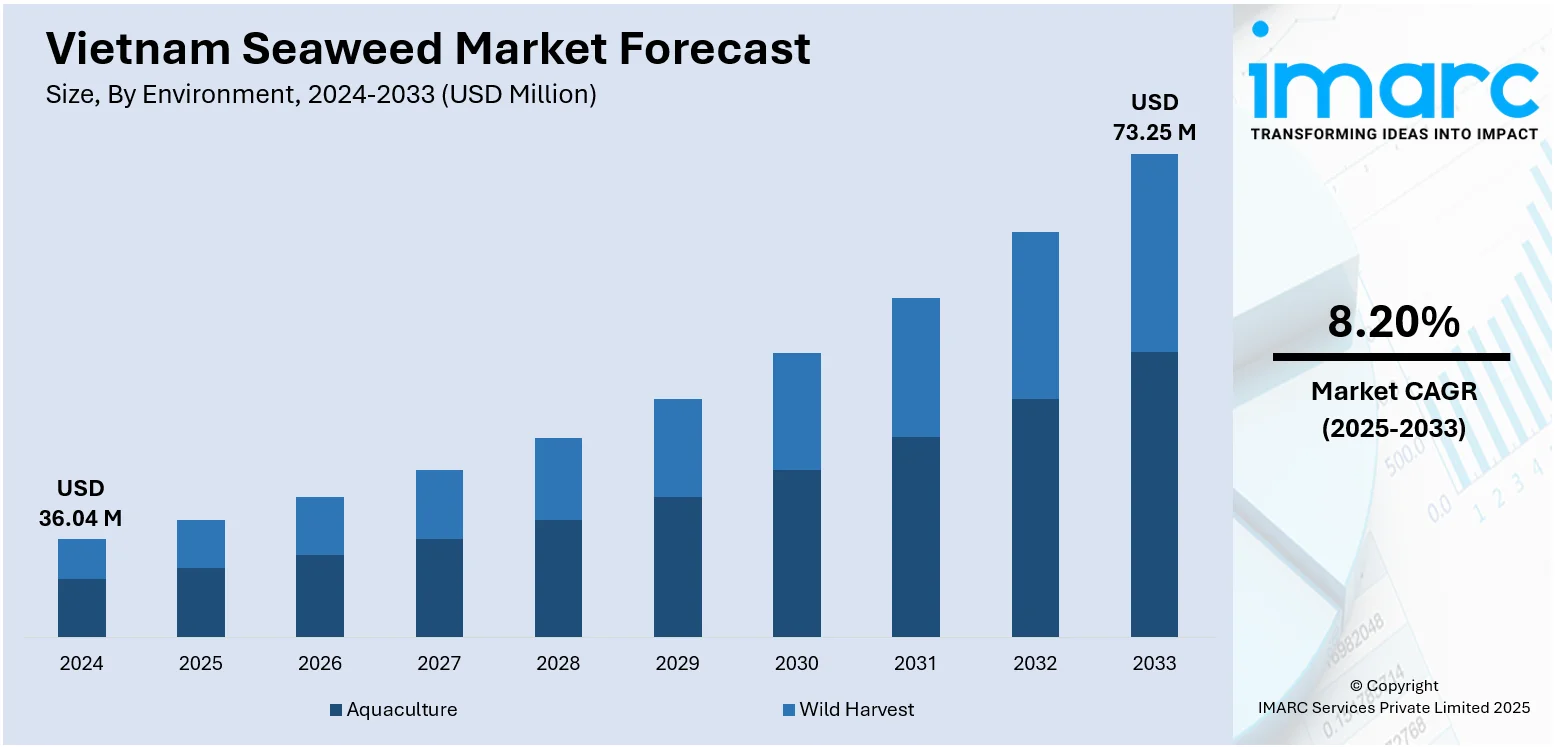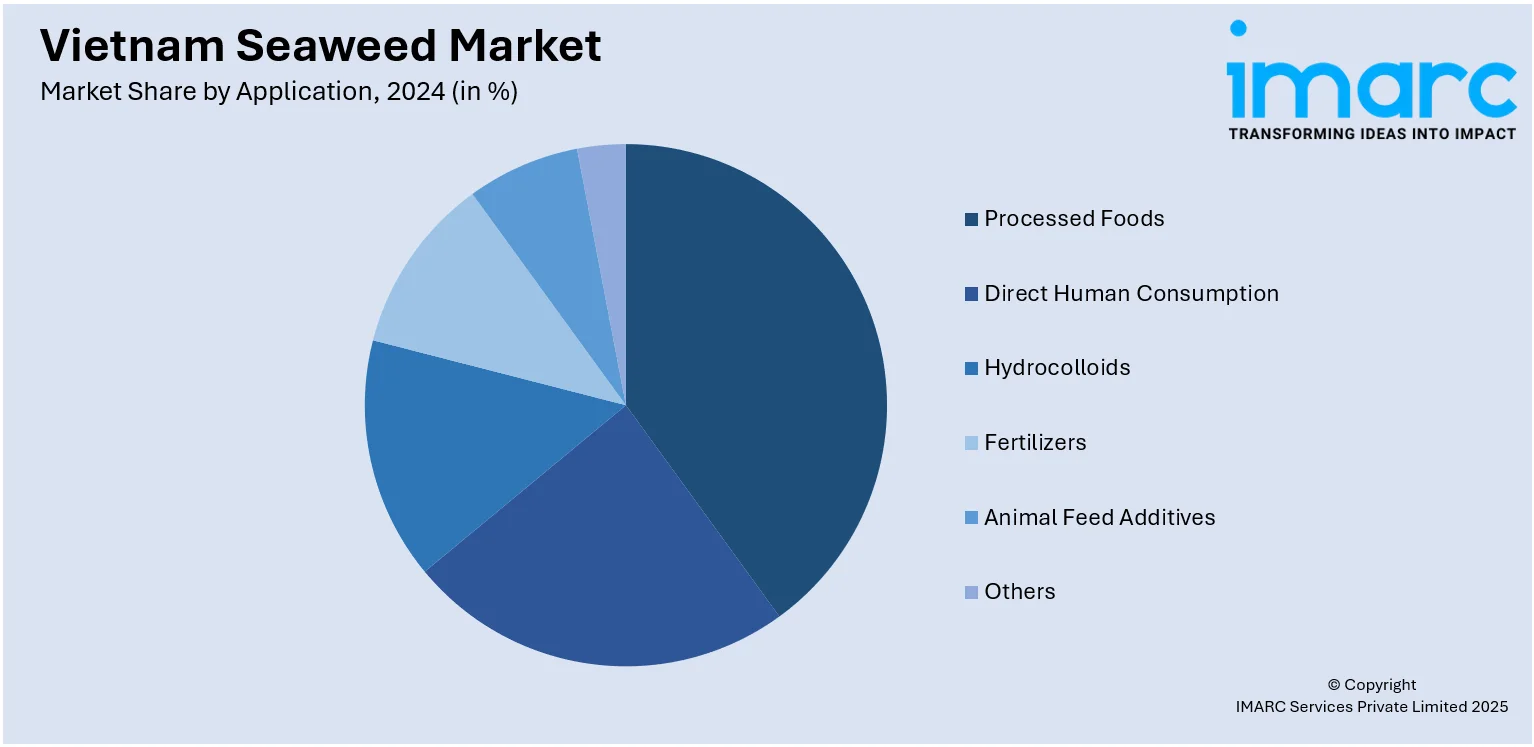
Vietnam Seaweed Market Size, Share, Trends and Forecast by Environment, Product, Application, and Region, 2025-2033
Vietnam Seaweed Market Overview:
The Vietnam seaweed market size reached USD 36.04 Million in 2024. Looking forward, IMARC Group expects the market to reach USD 73.25 Million by 2033, exhibiting a growth rate (CAGR) of 8.20% during 2025-2033. The market is driven by the scaling of coastal aquaculture infrastructure that supports traceable and cooperative seaweed supply chains. Integration of seaweed as a natural food ingredient is enhancing consumer appeal in culinary and plant-based product segments. Expanding use of seaweed-based bio-stimulants and bioremediation inputs is reinforcing its role in sustainable agriculture and environmental management, further augmenting Vietnam seaweed market share.
|
Report Attribute
|
Key Statistics
|
|---|---|
|
Base Year
|
2024 |
|
Forecast Years
|
2025-2033
|
|
Historical Years
|
2019-2024
|
| Market Size in 2024 | USD 36.04 Million |
| Market Forecast in 2033 | USD 73.25 Million |
| Market Growth Rate 2025-2033 | 8.20% |
Vietnam Seaweed Market Trends:
Development of Coastal Aquaculture Infrastructure
Vietnam’s long coastline and supportive coastal regulations have fostered the rapid development of seaweed aquaculture clusters along the central and southern regions. Farmers are transitioning to optimized seaweed farming methods that increase yield reliability and reduce operational risk, integrating simple processing techniques at the farm level. This evolution enables traceable supply chains that connect coastal producers to domestic processors and export channels. Infrastructure investments in drying, storage, and quality testing facilities support aggregation of raw material at scale. On February 6, 2024, Vietnam’s Ministry of Agriculture and Rural Development (MARD) announced a national target of producing 500,000 tonnes of seaweed annually by 2030 as part of its seafood industry development plan. In 2023, Vietnam cultivated seaweed across 16,500 hectares, yielding 150,000 tonnes, with some varieties generating over USD 8,100 per hectare for farmers. The alignment of coastal community livelihoods with exportable seaweed products is creating new agrarian value streams. Non-governmental organizations and technical assistance programs are collaborating with farmers to introduce best practices in seed selection and cultivation cycles. Furthermore, public-private partnerships are enabling local cooperative models that deliver reliable supply volumes required for downstream processing. As coordination between coastal community aquaculture and logistics frameworks improves, seaweed cultivation becomes more resilient and commercially viable, helping underpin Vietnam seaweed market growth.

To get more information on this market, Request Sample
Utilization in Agriculture and Environmental Management
Seaweed-based products are gaining acceptance in Vietnam’s agricultural and environmental sectors as natural bio-stimulants and remediation agents. Crop advisors and farmers are incorporating seaweed extracts into foliar sprays and soil conditioners, recognizing their role in enhancing plant health and stress tolerance. Environmental engineers are also evaluating seaweed biomass for bioremediation in aquaculture ponds, using it to absorb excess nutrients and improve water quality. On July 22, 2024, Vietnam’s International Collaboration Center for Sustainable Aquaculture and Fisheries (ICAFIS) launched the "Blue Ocean - Blue Foods" Program to establish carbon sinks within the fisheries sector, positioning seaweed cultivation as a key driver for marine carbon credits. With approximately 16,500 hectares yielding 150,000 tonnes of fresh seaweed in 2023 and a potential cultivation area of 900,000 hectares, the program highlights seaweed’s ability to absorb CO₂ 2.4 times more effectively than terrestrial plants and store up to 1,500 tonnes of greenhouse gases per sq km. Developers of organic farming systems are integrating seaweed inputs into regeneration protocols for high-value crops like coffee, pepper, and cashew. Research initiatives conducted by national universities are refining extraction methods to concentrate active growth compounds while eliminating unwanted salts. Producers are packaging these materials in formats suitable for smallholder farmers, including soluble powders and liquid concentrates. As agricultural policy increasingly supports sustainable farming transitions, organic and regenerative crop systems are expanding. The blending of environmental and agronomic applications positions seaweed as a multifunctional biomass that contributes to crop health, waste reduction, and resource efficiency in Vietnamese agriculture.
Vietnam Seaweed Market Segmentation:
IMARC Group provides an analysis of the key trends in each segment of the market, along with forecasts at the country and regional levels for 2025-2033. Our report has categorized the market based on environment, product, and application.
Environment Insights:
- Aquaculture
- Wild Harvest
The report has provided a detailed breakup and analysis of the market based on the environment. This includes aquaculture and wild harvest.
Product Insights:
- Red
- Brown
- Green
The report has provided a detailed breakup and analysis of the market based on the product. This includes red, brown, and green.
Application Insights:

- Processed Foods
- Direct Human Consumption
- Hydrocolloids
- Fertilizers
- Animal Feed Additives
- Others
The report has provided a detailed breakup and analysis of the market based on the application. This includes processed foods, direct human consumption, hydrocolloids, fertilizers, animal feed additives, and others.
Regional Insights:
- Northern Vietnam
- Central Vietnam
- Southern Vietnam
The report has also provided a comprehensive analysis of all major regional markets. This includes Northern Vietnam, Central Vietnam, and Southern Vietnam.
Competitive Landscape:
The market research report has also provided a comprehensive analysis of the competitive landscape. Competitive analysis such as market structure, key player positioning, top winning strategies, competitive dashboard, and company evaluation quadrant has been covered in the report. Also, detailed profiles of all major companies have been provided.
Vietnam Seaweed Market News:
- On June 30, 2023, the Asian Development Bank (ADB) signed a USD 15 million convertible note with Australis Holdings to expand barramundi and seaweed aquaculture in Vietnam, alongside an additional USD 3 million grant from the Climate Innovation and Development Fund (CIDF) for seaweed R&D. The investment will support operations in Van Phong Bay and fund research into cultivating Asparagopsis taxiformis, a seaweed species shown to significantly reduce methane emissions when used in cattle feed. With plans to achieve 50,000 tons of annual barramundi production and enhance Vietnam’s seaweed cultivation potential, the initiative underscores a strategic push for sustainable aquaculture in the Vietnam seaweed market.
- On March 10, 2025, Indonesia and Vietnam formalized an agreement to strengthen cooperation in fisheries and aquaculture, focusing on lobster, tuna, and seaweed cultivation. Signed during a state visit in Jakarta, the agreement includes provisions for information exchange, technology transfer, investment promotion, and human resource development through joint education and training programs. This bilateral commitment is poised to bolster Vietnam’s seaweed industry by enhancing cultivation expertise, market access, and regional production capacity.
Vietnam Seaweed Market Report Coverage:
| Report Features | Details |
|---|---|
| Base Year of the Analysis | 2024 |
| Historical Period | 2019-2024 |
| Forecast Period | 2025-2033 |
| Units | Million USD |
| Scope of the Report |
Exploration of Historical Trends and Market Outlook, Industry Catalysts and Challenges, Segment-Wise Historical and Future Market Assessment:
|
| Environments Covered | Aquaculture, Wild Harvest |
| Products Covered | Red, Brown, Green |
| Applications Covered | Processed Foods, Direct Human Consumption, Hydrocolloids, Fertilizers, Animal Feed Additives, Others |
| Regions Covered | Northern Vietnam, Central Vietnam, Southern Vietnam |
| Customization Scope | 10% Free Customization |
| Post-Sale Analyst Support | 10-12 Weeks |
| Delivery Format | PDF and Excel through Email (We can also provide the editable version of the report in PPT/Word format on special request) |
Key Questions Answered in This Report:
- How has the Vietnam seaweed market performed so far and how will it perform in the coming years?
- What is the breakup of the Vietnam seaweed market on the basis of environment?
- What is the breakup of the Vietnam seaweed market on the basis of product?
- What is the breakup of the Vietnam seaweed market on the basis of application?
- What is the breakup of the Vietnam seaweed market on the basis of region?
- What are the various stages in the value chain of the Vietnam seaweed market?
- What are the key driving factors and challenges in the Vietnam seaweed market?
- What is the structure of the Vietnam seaweed market and who are the key players?
- What is the degree of competition in the Vietnam seaweed market?
Key Benefits for Stakeholders:
- IMARC’s industry report offers a comprehensive quantitative analysis of various market segments, historical and current market trends, market forecasts, and dynamics of the Vietnam seaweed market from 2019-2033.
- The research report provides the latest information on the market drivers, challenges, and opportunities in the Vietnam seaweed market.
- Porter's five forces analysis assist stakeholders in assessing the impact of new entrants, competitive rivalry, supplier power, buyer power, and the threat of substitution. It helps stakeholders to analyze the level of competition within the Vietnam seaweed industry and its attractiveness.
- Competitive landscape allows stakeholders to understand their competitive environment and provides an insight into the current positions of key players in the market.
Need more help?
- Speak to our experienced analysts for insights on the current market scenarios.
- Include additional segments and countries to customize the report as per your requirement.
- Gain an unparalleled competitive advantage in your domain by understanding how to utilize the report and positively impacting your operations and revenue.
- For further assistance, please connect with our analysts.
 Request Customization
Request Customization
 Speak to an Analyst
Speak to an Analyst
 Request Brochure
Request Brochure
 Inquire Before Buying
Inquire Before Buying




.webp)




.webp)












